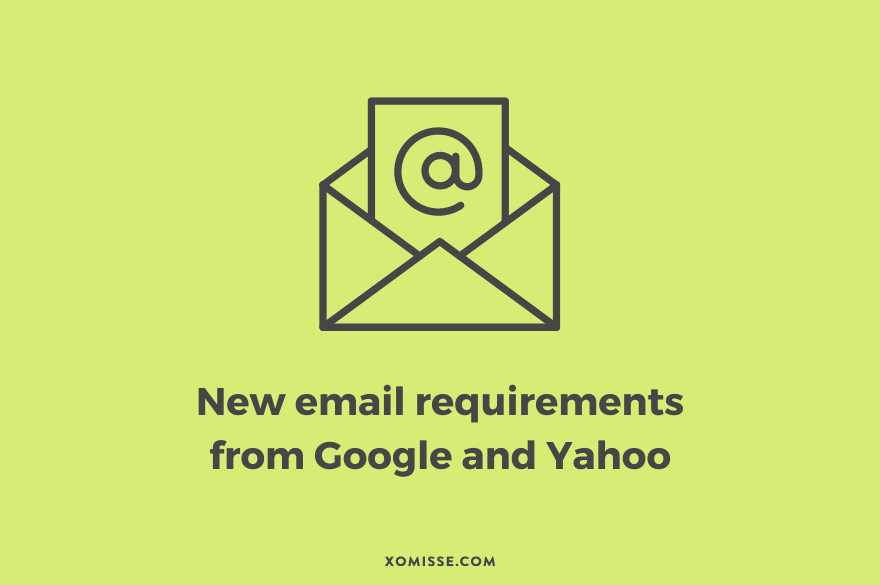Email providers have been fighting against spam for years and in a further attempt to protect users’ inboxes, they are now making what was once a recommendation into a requirement.
Back in October, both Google and Yahoo! announced that they will be introducing a new set of requirements for bulk email senders (those of us who send newsletters or other one-to-many emails) that will come into effect in February 2024.
Senders that don’t comply with the new requirements will start to see deliverability issues when sending bulk emails going forward such as emails being rejected or marked as spam.

What are the new requirements?
The new requirements from Google and Yahoo involve authenticating email and enabling easy unsubscribe. They also reiterate that we should avoid sending unsolicited emails.
Breaking the requirements down further, this means:
- No more bulk sending from gmail.com addresses
- Setting up SPF, DKIM and DMARC records
- Have one-click unsubscribe (through headers)
- Use the same domain in the sender’s From header and the SPF/DKIM
- Ensure that sending domains or IPs have valid forward and reverse DNS records
- Email format must meet the standards established by RFC 5322
- Keep spam rates reported in Google Postmaster Tools below 0.1%
I know some of that might sound very technical, but we’ll break it down below into smaller, more manageable tasks…
How do I comply with these requirements?
There are a couple of things you need to do in order to comply with this requirements.
1. Setting up an email address on your own domain
If you’re sending bulk emails with a gmail.com address you will need to set up an email address using your domain instead (for example contact@your-domain.com).
Check with your domain provider about how to set up custom email addresses or purchase one through Google Workspace.
2. Verifying your domain with your email tool
Next, you need to add that address to your email marketing software and verify your domain.
This will likely involve adding authentication records to your DNS settings through your domain provider.
These include DMARC, DKIM and SPF records, which help prevent spammers and other unauthorised parties from sending emails from your domain.
This seems complicated but you just need to copy and paste the information provided from your email marketing tool into your domains DNS editor, which may look something like this:
| Type | Name/Host/Alias | Value/Answer/Destination |
|---|---|---|
| TXT | _dmarc | v=DMARC1; p=none; |
| TXT | [selector]._domainkey.[domain] | v=DKIM1; p=[unique code] |
| TXT | @ | v=spf1 include:_spf.[domain] ~all |
You can have a more complex DMARC record, but at minimum you will need a basic DMARC record which looks like: v=DMARC1; p=none;
You can use this tool to check your settings.
Exact steps for this will vary depending on your email marketing tool and domain provider. Check to see if they have resources available with information about their specific platforms and these new requirements.
3. Easy one-click unsubscribe
As for having easy one-click unsubscribe within the header, check with your email marketing provider as the majority of them will be doing this for you.
Once you have correctly set up and verified your email address, it is likely that your email marketing tool will look after other requirements, such as the email format, using the same domain in the sender’s From header and the SPF/DKIM domain, and ensuring that sending domains or IPs have valid forward and reverse DNS record.
4. Checking your spam rate
Go to Google Postmaster Tools and add your domain. This will allow you to monitor the spam rate for your address in order to keep it below the recommended rate. It may take a few days to gather data about your address so don’t panic if you’re not seeing any information.
How is “bulk sending” defined?
While Google have stated that these requirements apply to those who send 5,000 or more messages a day to Gmail accounts, Yahoo haven’t specified.
In my opinion the safest bet is to comply with these new requirements, even if you are below the threshold as these steps are considered best practice.
Conclusion
As mentioned, these changes will be coming into effect from February 2024. Take some time to look over the main requirements and check with your email marketing tools for additional information before then.